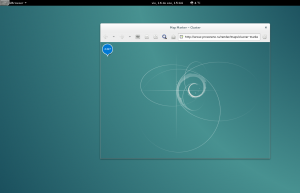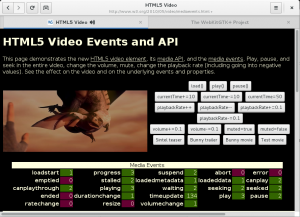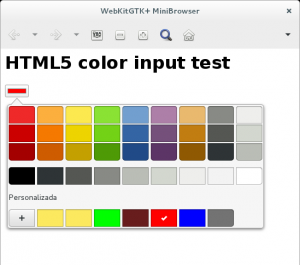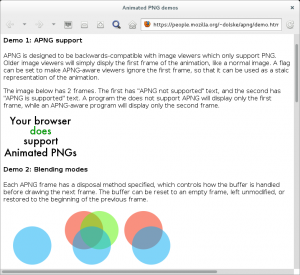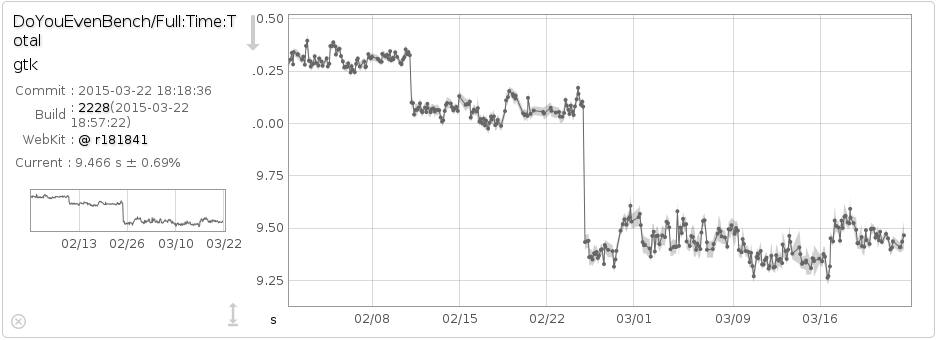We did it again, the Igalia WebKit team is pleased to announce a new stable release of WebKitGTK+, with a bunch of bugs fixed, some new API bits and many other improvements. I’m going to talk here about some of the most important changes, but as usual you have more information in the NEWS file.
FTL
FTL JIT is a JavaScriptCore optimizing compiler that was developed using LLVM to do low-level optimizations. It’s been used by the Mac port since 2014 but we hadn’t been able to use it because it required some patches for LLVM to work on x86-64 that were not included in any official LLVM release, and there were also some crashes that only happened in Linux. At the beginning of this release cycle we already had LLVM 3.7 with all the required patches and the crashes had been fixed as well, so we finally enabled FTL for the GTK+ port. But in the middle of the release cycle Apple surprised us announcing that they had the new FTL B3 backend ready. B3 replaces LLVM and it’s entirely developed inside WebKit, so it doesn’t require any external dependency. JavaScriptCore developers quickly managed to make B3 work on Linux based ports and we decided to switch to B3 as soon as possible to avoid making a new release with LLVM to remove it in the next one. I’m not going to enter into the technical details of FTL and B3, because they are very well documented and it’s probably too boring for most of the people, the key point is that it improves the overall JavaScript performance in terms of speed.
Persistent GLib main loop sources
Another performance improvement introduced in WebKitGTK+ 2.12 has to do with main loop sources. WebKitGTK+ makes an extensive use the GLib main loop, it has its own RunLoop abstraction on top of GLib main loop that is used by all secondary processes and most of the secondary threads as well, scheduling main loop sources to send tasks between threads. JavaScript timers, animations, multimedia, the garbage collector, and many other features are based on scheduling main loop sources. In most of the cases we are actually scheduling the same callback all the time, but creating and destroying the GSource each time. We realized that creating and destroying main loop sources caused an overhead with an important impact in the performance. In WebKitGTK+ 2.12 all main loop sources were replaced by persistent sources, which are normal GSources that are never destroyed (unless they are not going to be scheduled anymore). We simply use the GSource ready time to make them active/inactive when we want to schedule/stop them.
Overlay scrollbars
GNOME designers have requested us to implement overlay scrollbars since they were introduced in GTK+, because WebKitGTK+ based applications didn’t look consistent with all other GTK+ applications. Since WebKit2, the web view is no longer a GtkScrollable, but it’s scrollable by itself using native scrollbars appearance or the one defined in the CSS. This means we have our own scrollbars implementation that we try to render as close as possible to the native ones, and that’s why it took us so long to find the time to implement overlay scrollbars. But WebKitGTK+ 2.12 finally implements them and are, of course, enabled by default. There’s no API to disable them, but we honor the GTK_OVERLAY_SCROLLING environment variable, so they can be disabled at runtime.
But the appearance was not the only thing that made our scrollbars inconsistent with the rest of the GTK+ applications, we also had a different behavior regarding the actions performed for mouse buttons, and some other bugs that are all fixed in 2.12.
The NetworkProcess is now mandatory
The network process was introduced in WebKitGTK+ since version 2.4 to be able to use multiple web processes. We had two different paths for loading resources depending on the process model being used. When using the shared secondary process model, resources were loaded by the web process directly, while when using the multiple web process model, the web processes sent the requests to the network process for being loaded. The maintenance of this two different paths was not easy, with some bugs happening only when using one model or the other, and also the network process gained features like the disk cache that were not available in the web process. In WebKitGTK+ 2.12 the non network process path has been removed, and the shared single process model has become the multiple web process model with a limit of 1. In practice it means that a single web process is still used, but the network happens in the network process.
NPAPI plugins in Wayland
I read it in many bug reports and mailing lists that NPAPI plugins will not be supported in wayland, so things like http://extensions.gnome.org will not work. That’s not entirely true. NPAPI plugins can be windowed or windowless. Windowed plugins are those that use their own native window for rendering and handling events, implemented in X11 based systems using XEmbed protocol. Since Wayland doesn’t support XEmbed and doesn’t provide an alternative either, it’s true that windowed plugins will not be supported in Wayland. Windowless plugins don’t require any native window, they use the browser window for rendering and events are handled by the browser as well, using X11 drawable and X events in X11 based systems. So, it’s also true that windowless plugins having a UI will not be supported by Wayland either. However, not all windowless plugins have a UI, and there’s nothing X11 specific in the rest of the NPAPI plugins API, so there’s no reason why those can’t work in Wayland. And that’s exactly the case of http://extensions.gnome.org, for example. In WebKitGTK+ 2.12 the X11 implementation of NPAPI plugins has been factored out, leaving the rest of the API implementation common and available to any window system used. That made it possible to support windowless NPAPI plugins with no UI in Wayland, and any other non X11 system, of course.
New API
And as usual we have completed our API with some new additions:
- WebView session save/restore: It’s now possible to serialize and deserialize a WebKitWebView session which includes information like the history navigation, the scroll position or HTML POST data.
- Notifications click action: It allows to notify WebKit that a web notification has been clicked by the user to perform the appropriate action.
- Console messages API: This is one of APIs we never ported to WebKit2. It’s now available as part of the Web Extensions API, WebKitWebPage emits a signal every time a message is sent to the JavaScriptConsole with a WebKitConsoleMessage parameter containing all the message information.
- Beforeunload events: A new script dialog type WEBKIT_SCRIPT_DIALOG_BEFORE_UNLOAD_CONFIRM and a new method webkit_web_view_try_close() have been added to allow applications handle and honor websites using beforeunload events.
- Request HTTP method: It’s now possible to query the HTTP method used by a WebKitURIRequest with webkit_uri_request_get_http_method().

